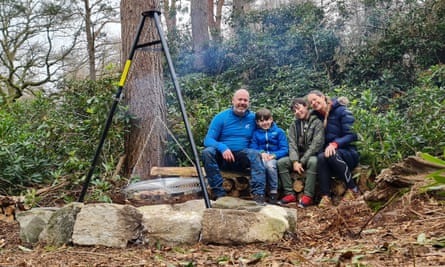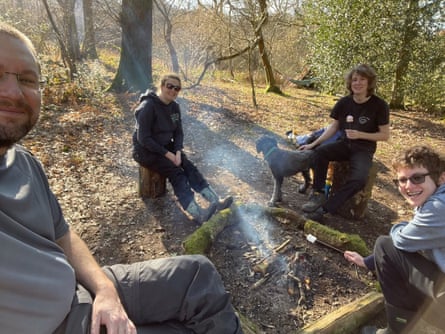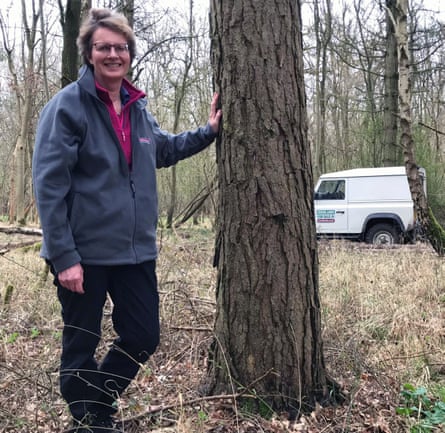Lockdown spurred some people to start yoga, crack on with DIY or watch more Netflix. For others, it prompted them to splash out on their very own green oasis.
Owen Gardner, 46, and his wife, Anya, 48, who live in Farnborough in Hampshire, decided to buy 2.2 hectares (5.5 acres) of woodland in Surrey last summer.
“We had toyed with the idea since camping at a small woodland campsite a year ago, and have spent a lot of time at forest sites like Alice Holt in Hampshire,” says Owen, a senior director in the professional services division of a software company. “We didn’t have the money, or the time, back then but when a friend bought some acres during lockdown, we had a look locally to see what was available.”
The couple ended up falling in love with the mature trees in a plot in Surrey, seven miles from their home, and within six weeks also bought the two neighbouring woods, spending a total of £80,000.
 View image in fullscreenThe Gardner family enjoy their woodland plot. Photograph: Owen Gardner
View image in fullscreenThe Gardner family enjoy their woodland plot. Photograph: Owen Gardner
The Gardners are among a growing number of Britons who have acquired woodland since the Covid crisis began.
Joe Fielding, managing director at the broker firm Woods4Sale, says sales have doubled over the past 12 months. “We used to have around 80 woodlands on our website at any time but now are often down to 20,” he says.
In-demand woodlands tend to be those with additional features such as streams, ponds and ruins. “Some people like large mature trees, with lots of open spaces for camping and recreation but others like dense vegetation where they can hide and not be seen,” Fielding says.
But one key point is accessibility. “Remoteness is attractive but location in relation to owners’ homes is important,” he says.
They want somewhere to go with kids and experience nature, and put their money somewhere fairly secureWoodlands.co.uk’s Richard Scholfield
Richard Scholfield, an estate manager for the company Woodlands.co.uk, has also seen demand for small woodlands double since the coronavirus pandemic.
“I think there’s a parallel with people moving out of London to the countryside,” he says. “People have been stuck inside. They want somewhere to go with kids and experience nature, and put their money somewhere fairly secure.”
Woodland generally costs an average of about £10,000 for 0.4 hectares (an acre). On top of that, Woodlands.co.uk says the legal process of buying a plot will typically cost about £600-£900. There is a small Land Registry charge for getting the title registered (about £40) but there is no stamp duty as long as the purchase price is below £150,000 in England and Northern Ireland. There are different stamp duty rules in Scotland and Wales. Woodlands do not attract council tax or business rates, or other similar charges.
Finance director Gavin Hills, 44, and his wife, Tiki, 36, fulfilled an eight-year dream when they bought a 0.6-hectare plot (1.5 acres) in Northchapel, near Petworth in West Sussex, just before Christmas.
A 30-minute drive from their home in Littlehampton, and with a mix of oak, sweet chestnut and silver birch trees, the woodland is also rather handily within walking distance of a pub and shop. The couple fell in love with the plot and bought it for £25,000, plus solicitor fees of just over £1,000, on the same day they saw it.
“We had to cancel holidays worth about £4,000, so we put money towards the wood, and that – along with our existing savings – meant we could afford it,” Gavin says.
 View image in fullscreenGavin, Charlie, Tiki and Samuel Hills make the most of their woodland plot, which is a 30-minute drive from their West Sussex home. Photograph: Gavin Hills
View image in fullscreenGavin, Charlie, Tiki and Samuel Hills make the most of their woodland plot, which is a 30-minute drive from their West Sussex home. Photograph: Gavin Hills
Although lockdowns have meant they could not visit as often as they would have liked, they have called in a few times. “We’ve done some coppicing, and we’re looking forward to camping down there and inviting friends, especially in the summer months,” Gavin says. “It’s a lovely place to sit and spend time relaxing in nature. It’s very good for the soul.”
For those dreaming of escaping to their own woodland oasis, it is worth looking at what you can and can’t do with the land first. Legally you are normally only allowed to camp overnight in your woodland for up to 28 days a year without planning permission, although in England this has been extended to 56 days a year until the end of December 2021, thereby making it easier for landowners to set up pop-up campsites.
Other limitations apply, too. “While you may enjoy the use of the woodland through recreational activities such as camping or walking, there will be restrictions against certain uses of the land,” says Raazia Ibrahim, a principal lawyer and the head of commercial property at the law firm Linder Myers. “Development of the land or any form of building will be restricted.”
Generally, a place to store equipment for woodland use is allowed, although you will usually need to apply for permission – Woodlands.co.uk has more on its site about sheds and storage.
If the idea of a green burial appeals, you can be buried in your own woodland but, again, this is subject to certain rules. There is more about private land burials on the Natural Death Centre’s website.
Ibrahim recommends woodland owners buy public liability insurance. “Having the public walk through or near your woodland site could have consequences if persons were to suffer any injuries as a result of any falling branches or concealed tree stumps whereby owners could be sued for compensation.”
Judith Millidge, a coordinator for the Small Woodland Owners’ Group and the editor of Living Woods Magazine, warns that security can be an issue. There can be problems with trespassers and criminal damage, she says, adding: “We advise never to leave tools in woodland or sheds, and we encourage people to keep the location quite vague.”
 View image in fullscreenJudith Millidge says: ‘From my experience, people don’t sell their woodlands on that often once they have bought one.’ Photograph: J Millidge
View image in fullscreenJudith Millidge says: ‘From my experience, people don’t sell their woodlands on that often once they have bought one.’ Photograph: J Millidge
Some people might see their plot as an investment but Millidge, who is an owner herself, says that does not seem to be the main pull for buyers.
“From my experience, people don’t sell their woodlands on that often once they have bought one. Perhaps if they move to the other side of the country, they might want to sell. But people seem to love them and have them as long as they possibly can, and very often pass them on to family.”
She says: “By and large, people go for the day, to do a bit of wildlife watching, put up rope swings for children and sit around and relax.” Don’t let the rain put you off either. “It’s amazing what canopies and tarpaulins can do to keep you dry,” she adds.
Angela, 56, from Surrey, paid £48,000 in February for a small plot in the Surrey Hills.
“I spend a lot of time outdoors and have long imagined having a woodland but didn’t think I would find anything that was suitable and close to home until a friend alerted me to Woods4Sale, and I found a listing for a local wood,” she says. “My partner and I enjoy being outside, camping and making/creating, including spoon carving, woodworking, experimenting with pewter casting and so on. The peace, tranquility and privacy of the woods was a key factor, as was the opportunity to improve the area for wildlife.
“As I live in a flat and don’t have access to a private garden, it does provide a safe place to go, as I’m further away from people in the wood than outside my home. I consider it my outdoor gym.”
While Ecology building society offers specific small woodland mortgages, Fielding says buyers often remortgage their main home to fund their purchase or “use other money that is sitting in nonperforming investments” .
I’ve always loved the idea of protecting a patch of land or trees more than owning a homeSabine Zetteler
Sabine Zetteler, 39, the owner of the communications agency Zetteler, has several reasons for wanting to have her own patch of green. “I’m planning to buy some woods in the countryside to preserve and protect as I can’t imagine being able to afford a place in London,” she says.
“I’ve always loved the idea of protecting a patch of land or trees more than owning a home. The idea of one day having a hut in the middle of a wild patch to escape to and let our friends borrow, and to have the ability to travel somewhere to fall asleep in nature … I hope to invest in a plot before I turn 40. To protect a patch and enable biodiversity to thrive just seems like the best investment and legacy.”
For the Gardners, trying to find a slice of calm during the pandemic was a big factor in their purchase, and Owen says the plot has “proved to be a lifeline during this strange year”. Money that might otherwise have been spent on holidays, commuting, days out and so on has led to an investment for his family’s wellbeing, he adds.
Sometimes the family cycle to their plot before setting up camp, throwing logs on to a firepit, watching a film on a portable projector and screen, and sleeping in hammocks.
“We’ve visited every weekend and even during the week,” Owen says. “From my perspective, I had a high-pressured job, and it gives me the space for mindfulness and peacefulness. You can’t do anything other than pretend to be a lumberjack.”
His sons Caleb, 10, and Teigan, nine, are at an age where they can properly explore. Owen says the family were fortunate enough to have savings to fulfil their dream. “We did take a moment where we thought: ‘Are we spending this much money on woodland?’ but we know it won’t go down in value and it’s a privilege to have custody of this area and enjoy it.”


